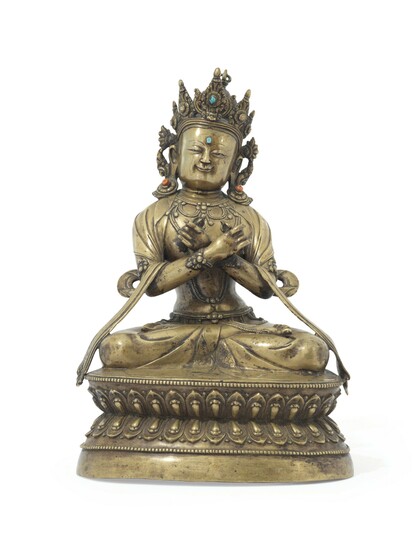
Item: Vajradhara Buddha - (solitary)
| Origin Location | Tibet |
|---|---|
| Date Range | 1400 - 1499 |
| Lineages | Buddhist |
| Material | Metal, Stone Inset: Coral, Turquoise |
| Collection | Private |
Classification: Deity
Appearance: Peaceful
Gender: Male
Vajradhara, Buddha (Tibetan: dor je chang, sang gye. English: the Vajra Holder, Enlightened One). The primordial buddha, personification of the dharmakaya - truth body of enlightenment and progenitor of the Vajrayana system of buddhism.
Sanskrit: Vajradhara Tibetan: Dor je chang
Tibetan: Dor je chang
"Master of all-pervasive pristine awareness, unmoving great bliss of dharmata, unsurpassed treasure of wishing jewels; homage to the great Vajradhara." (Nyingma liturgical verse).
According to the Nyingmapa School Vajradhara is an activity emanation of buddha Samantabhadra. The Sarma schools hold Vajradhara as the secret form of Shakyamuni Buddha and the combined essence of all the buddhas of the ten directions and three periods of time gathered as one. It is from Vajradhara that such tutelary deities as Guhyasamaja, Shri Hevajra and Chakrasamvara arise.
These three sculpture of Vajradhara appear to have been made in the same Tibetan workshop at roughly the same time. The style of the sculpture in general follows that of Tsang Province where incising is popular and gilding less common. Note the similarities in the shape and structure of the faces, ornamentation, and double lotus base.
It is possible that these three Vajradharas are the first figure in sets of the Sakya Margapala (Lamdre) Lineage.
Jeff Watt 4-2014
Collection: Christie's, Jan. 28, 2014
Buddhist Deity: Vajradhara Main Page
Sculpture: Tsang Province Atelier, Tibet
Sculpture: Tsang Province Atelier (Bodhisattva/Deity)
Sculpture: Tsang Province Atelier (Vajradhara)

